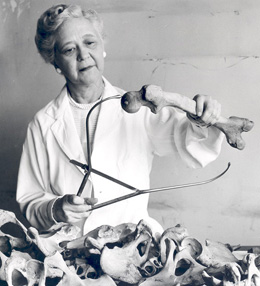Mildred Trotter (1899-1991)
Mildred Trotter, a noted anatomist and anthropologist, was born February 3, 1899 in Monaca, Pennsylvania. She grew up on her family’s farm, graduated from high school in nearby Beaver Falls, and matriculated to Mt. Holyoke College in 1916. After receiving her undergraduate degree in 1920, Trotter came to Washington University as a “Fellow in Hypertrichiasis” to assist in a research project on excessive hair growth. Trotter was able to apply the research towards a master’s degree in Anatomy, which she completed in 1921, followed by a doctorate in Anatomy in 1924. Trotter was appointed an assistant in the Department of Anatomy in 1922, joining the five other women on the staff of the medical school at the time. In 1924 she was promoted to instructor of Anatomy.
For the 1925-26 academic year, Trotter accepted a National Research Council Fellowship in Physical Anthropology enabling her to study at the University of Oxford in England under Professor Arthur Thomson. While there, Trotter studied and compared the vertebral columns of skeletons in the University Museum’s collection. That study led to both Trotter’s first publication on bone, “The Moveable Segments of the Vertebral Column in Old Egyptians,” and a lasting effect on her future research – Trotter found that she enjoyed studying skeletons better than studying hair.
Though she was awarded a second year at Oxford, Trotter chose to return to the U.S. and Washington University when Robert J. Terry, the head of the Department of Anatomy, promised her a promotion to assistant professor. Four years later Trotter was promoted to associate professor of Anatomy and granted tenure. In 1946 Trotter was promoted to professor of Gross Anatomy, becoming the first woman to hold that rank at the Washington University School of Medicine. Trotter’s title became professor of Anatomy in 1958, a position she held until her mandatory retirement at the age of 68, in 1967. She then became professor emeritus and lecturer, and remained active in her research and writing until 1984.
In 1948-49, Trotter took a leave of absence from Washington University to serve as an anthropologist in the Central Identification Laboratory of the American Graves Registration Service (under the aegis of the U.S. Army Quartermaster Corps) at Schofield Barracks in Hawaii. Though her primary responsibility was to use her expertise to identify the skeletal remains of war dead in the Pacific zone, Trotter also undertook research to study the skeletal remains of known war dead. Her aim was to improve stature estimates made for Americans from the lengths of long limb bones – the research resulted in new formulas for the estimation of stature that are still used today in forensic medicine. Trotter returned to the Pacific for three months in the fall of 1951, when she again served as an anthropologist for the U.S. Army at Fort McKinley in the Philippines.
In the summer of 1963 Trotter served as visiting professor of Anatomy at Makerere University College in Kampala, Uganda. Under the Rockefeller Foundation’s program in Medical and Natural Sciences, Trotter assisted in starting the teaching program in the Department of Anatomy at Makerere and in preparing the post-graduate students for their board examinations.
Dr. Trotter’s research interests were centered on human anatomy and physical anthropology. Her research led to discoveries about the structure and distribution of hair, and the growth, racial and sexual differences, and aging of the human skeleton. Her publications exceeded 100 titles. She contributed to not only scientific journals but also textbooks and encyclopedias. The honorary Sc.D. was conferred upon Mildred Trotter by Western College for Women in 1956 and by Mt. Holyoke College in 1960. The honorary D.Sc. was conferred by Washington University in 1980.
Trotter served as president of the Missouri State Anatomical Board from 1957 to 1967, and as the president of the St. Louis Anatomical Board from 1941 to 1948 and again from 1949 to 1967. In the 1950s Trotter was instrumental in getting Missouri lawmakers to make it possible for people to will their bodies to medical schools for research and teaching. Trotter continued her research and publishing, coming to her lab regularly until she suffered a disabling stroke the day before her 86th birthday. Upon her death in1991, her body was donated to the Washington University School of Medicine.

Related Resources:
- Mildred Trotter Bibliography
- Mildred Trotter Oral History
- Mildred Trotter Papers Finding Aid
- Images of Mildred Trotter
Back to Biographies


